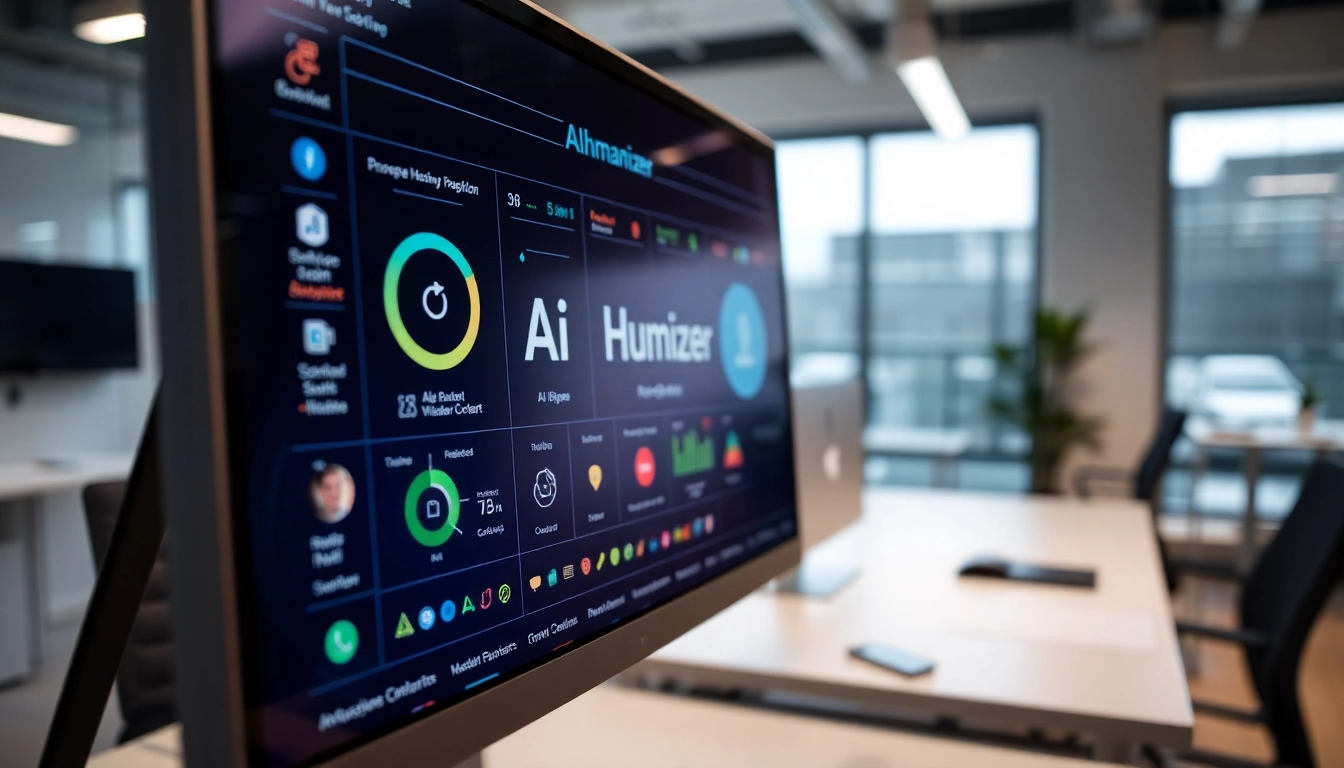Understanding the Human or Not Game: Basics and Purpose
In an era where artificial intelligence (AI) increasingly integrates into our daily lives, the ability to discern between human and machine conversations has become both a fascinating and critical skill. Enter human or not, an innovative social Turing game designed to challenge your perception, intuition, and analytical thinking. This game isn’t just about entertainment; it serves as a window into the evolving capabilities of AI and how human cognition interacts with it.
What Is the Human or Not AI Challenge?
The Human or Not AI challenge is an interactive social game where you engage in a two-minute conversation with an anonymous entity—either a fellow human or an advanced AI chatbot. Your task is to accurately identify the nature of your conversation partner based solely on their responses. The challenge is rooted in the famous Turing Test, which aims to evaluate a machine’s ability to imitate human-like responses convincingly.
How Does the Game Work? Key Mechanics Explained
The core mechanic is simple: start a conversation, usually via a chat interface designed for quick exchanges. Once the two-minute duration expires, you are prompted to classify your interlocutor as either a human or an AI. Despite its simplicity, the game is deeply engaging because of the sophisticated natural language responses generated by AI, which can often mimic human nuances quite convincingly.
Implementations of this game leverage state-of-the-art AI models such as GPT-4, which enable chatbots to craft responses that can range from highly realistic to subtly offbeat or mechanical—clues you need to identify to win. The game primarily challenges your observational skills and understanding of conversational cues, making it relevant for anyone interested in AI, psychology, or communication skills.
Why Is Testing AI Detection Skills Relevant Today?
The importance of honing AI detection skills extends beyond mere curiosity. As AI systems become more integrated into customer service, content creation, and social platforms, distinguishing AI-generated content from human interaction is vital for maintaining authenticity, privacy, and security. Furthermore, these skills contribute to broader digital literacy, enabling users to navigate a landscape increasingly filled with AI-generated media, misinformation, and automated interactions effectively.
Strategies to Improve Your Human or Not Skills
Critical Observation Techniques for Better Guessing
Successful players develop refined observation techniques that focus on identifying subtle cues. These include analyzing response timing—AI might respond with promptness or delays indicating processing time—linguistic patterns such as repetitive phrases or overly formal language, and emotional cues like humor, empathy, or personal anecdotes that might seem less natural or inconsistent.
Practicing active listening and paying close attention to how responses unfold can help you spot anomalies or patterns indicative of machine responses. For example, AI often struggles with nuanced humor, idiomatic expressions, or abrupt topic shifts that don’t quite fit the conversation flow.
Common Clues and Subtle Cues in AI Conversations
AI responses, particularly from advanced models, can be remarkably human-like. However, common clues include:
- Repetition: AI may reuse phrases or sentence structures within or across conversations.
- Lack of Personal History: AI can’t truly share personal experiences; responses may reflect generic or overly cautious language.
- Over-Formality or Uniform Tone: A tendency to respond with consistent politeness or formality regardless of context.
- Logical but Slightly Off-Bocus: Responses are often coherent but may lack deep understanding or emotional depth.
- Difficulty with Ambiguous or Subtle Contexts: AI can falter when interpreting sarcasm, irony, or cultural references.
Practicing with Purpose: Tips for Winning More Rounds
To enhance your skills, consider the following approaches:
- Experiment with Diverse Questions: Ask unpredictable or humorous questions to test for spontaneity.
- Focus on Emotional Depth: Probe for personal stories or feelings—humans tend to share personal nuances that AI may not replicate convincingly.
- Learn AI Limitations: Keep abreast of current AI capabilities and known weaknesses to spot telltale signs.
- Engage in Regular Practice: Play frequently across different platforms to hone your intuition and adapt to evolving AI behaviors.
Technologies Powering Human or Not AI
AI Technologies Behind the Conversations, Including GPT-4
The backbone of Human or Not is built upon cutting-edge AI technology—primarily advanced large language models like GPT-4. These models are trained on vast datasets to generate contextually appropriate, coherent, and sometimes remarkably human-like responses. They use deep learning techniques, transformer architectures, and multi-modal capabilities to mimic nuanced human communication effectively.
Beyond GPT-4, other AI frameworks and algorithms enhance the game’s responsiveness, accuracy in response generation, and contextual understanding, making the game both challenging and engaging. Continuous updates and improvements ensure the AI remains sophisticated, pushing players to refine their detection skills.
Ensuring Privacy and Safety in the Game Environment
User privacy is paramount. Human or Not prioritizes the safety of its players by implementing strict data privacy policies. Conversations are conducted anonymously, with no personally identifiable information collected without explicit consent. Encryption protocols and compliance with privacy standards create a secure environment where users can enjoy the game without concern, establishing trust and encouraging active participation.
Future Developments in Human or Not and AI Detection
The future of Human or Not hinges on integrating emerging AI detection tools, such as forensic language analysis and pattern recognition algorithms. Researchers are developing techniques like stylometry, which analyze writing style signatures, and AI behavior profiling to identify subtle machine artifacts.
Enhanced user interfaces, richer interaction modes (such as voice or video chat), and integration with emerging AI safety protocols will also elevate the game. These advancements aim to not only boost entertainment but also contribute to societal efforts in AI literacy and digital authenticity.
Maximizing Engagement and Learning from Human or Not
Community Insights and User Tips
The Human or Not community is vibrant and often shares invaluable tips for improving detection skills. Forums like Reddit and dedicated social media groups offer insights on common AI response patterns, effective question types, and interesting anecdotes from gameplay. Engaging with these communities can accelerate your learning curve and expose you to diverse conversational scenarios.
Sharing Results and Improving Your Accuracy
Tracking your success metrics—such as percentage of correct identification—helps identify patterns and areas for improvement. Some platforms offer analytics dashboards, letting players review their performance over time and refine their detection methods. Sharing your experiences and strategies with peers fosters collective growth and sharpens your overall skills.
Joining the Conversation: Social Media and Feedback
Active participation on social media channels, including Twitter, Discord, or official forums, keeps you informed about updates, new features, and AI breakthroughs. Providing feedback to developers not only shapes future iterations but also fosters a community dedicated to understanding AI’s evolving landscape.
Evaluating Your Performance and Next Steps
Interpreting Your Success Rate in Human or Not
Understanding your accuracy rate helps measure your perceptual skills. A higher success rate indicates a keen eye for linguistic and behavioral cues, while lower scores highlight areas for targeted improvement. Regular practice and deliberate analysis of incorrect guesses accelerate skill acquisition.
Advanced Tactics for Pro Level AI Spotting
Advanced players utilize techniques such as:
- Pattern Recognition: Identifying inconsistencies or unnatural language traits.
- Cultural and Contextual Awareness: Using cultural references or idiomatic expressions to differentiate responses.
- Questioning Strategies: Employing cryptic, irony, or paradoxical questions to expose AI limitations.
- Environmental Context: Observing response timing and interaction flow for anomalies.
Integrating Human or Not Skills into Broader AI Awareness
Beyond gaming, these skills enhance digital literacy, critical thinking, and awareness of AI’s capabilities and limitations. They bolster your capacity to evaluate online interactions, detect fake content, and navigate AI-driven media responsibly. As AI becomes ubiquitous, proficiency in these areas is increasingly vital for informed citizenship.













